#Saburō Date
Text
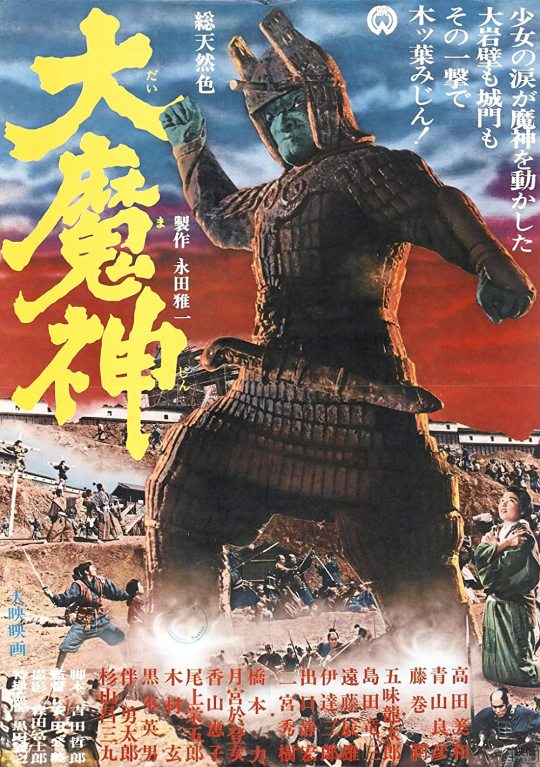


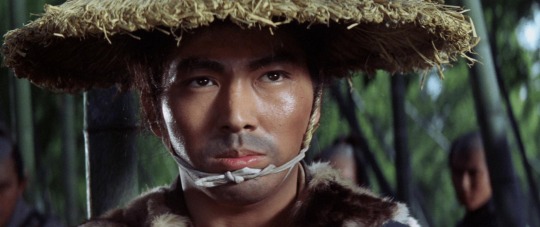




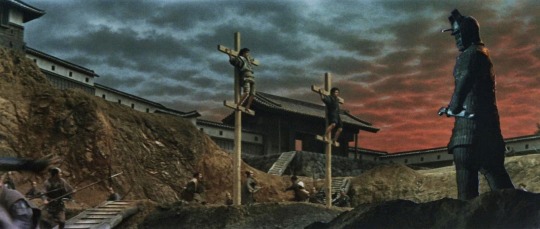

Daimajin (Majin, the Monster of Terror, 1966)
"You realise you started as a drifter, and yet you've been basking in the lord's wealth? How dare you! What do you have against our lord?"
"I have nothing against him - nor do I owe him anything."
#大魔神#daimajin#japanese cinema#kaiju film#Kimiyoshi Yasuda#Tetsuro Yoshida#miwa takada#Masako Morishita#Yoshihiko Aoyama#Hideki Ninomiya#Jun Fujimaki #Otome Tsukimiya#Ryūtarō Gomi #Ryūzō Shimada#Tatsuo Endō#Saburō Date#Shosaku Sugiyama#Hideo Kuroki#majin the monster of terror#oh this was funnnn. I'm a complete novice on kaiju films but i feel like I'd be more into them if they're all like this#ie. as much if not more emphasis on political infighting and feudal disputes as on the big monster things#i can see how this might frustrste some; our big friend doesn't really turn up until the final ten minutes and whilst#that's a very impressive ten minutes i imagine some viewers felt short changed. not me! i really enjoyed the romantic tale that built up to#the carnage; brave samurai and evil usurpers clashing as the poor village people are down trodden and enslaved. very old fashioned in some#ways and undoubtedly full of folklore and history that I'm none too familiar with but i can honestly say it was a really fun time#plus when Big Man did start to smash... boy did he smash#oh to be a young princess with a handsome protector and a giant rubble demon god to do my bidding#one can dream....
23 notes
·
View notes
Text

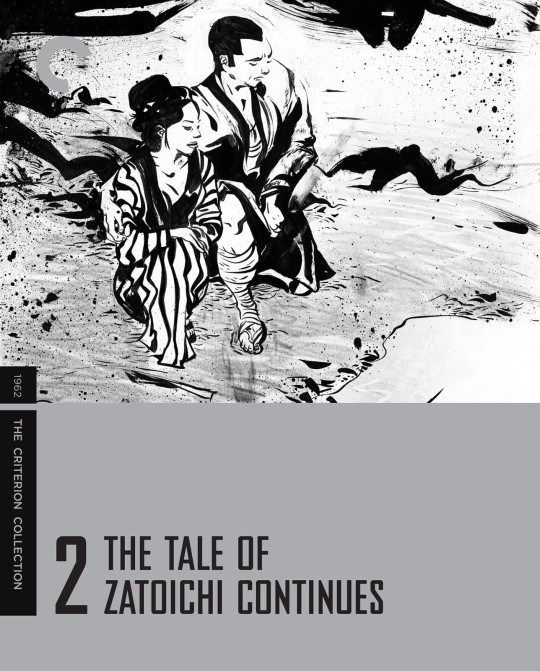
WATCHING
#the tale of zatoichi continues#the tale of Zatoichi continues (1962)#shintarô katsu#shintaro katsu#watching#tomisaburo wakayama#Zoku Zatōichi Monogatari#Yoshie Mizutani#Tomisaburō Wakayama#Yutaka Nakamura#Sōnosuke Sawamura#Eijirō Yanagi#Saburō Date#Yaeko Mizutani#Masayo Banri#Japanese movie#samurai movie#samurai#続・座頭市物語#Zatoichi#jidaigeki
1 note
·
View note
Text
The Tsurumaru-Kuninaga Sword

In Eishō six (永承, 1051) Koremochi´s son Shigemochi (繁茂) assumed the office of Dewa Jōnosuke (出羽城介), i.e. he became the governor of Dewa and Akita province.
From the Kamakura period onwards, this office was renamed Akita Jōnosuke (秋田城介) and because of the name Jōnosuke, Shigemochi´s successors, like Tarō Sadashige, took the family name Jō (城). On the other hand, the sword chronicle Go Tōken Ki (御刀剣記) of the Date family writes that around Hōgen (保元, 1156-1159) the sword was originally owned by a certain Murakami Tarō Nagamori (村上太郎永守) from which it came into the possession of Seino Saburō Nyūdō (清野三郎入道). The Seino were a Shinano-based branch of the Murakami family. With the next owner Jō Mutsu no Tarō Chikanboku (城陸奥ノ太郎近延) – a successor of the Heian-period Jō family – the sword was, according to tradition, lost in the turmoils of the Mongol invasion of 1281. The chronicle says that he killed many Mongols with it before he died in one of the countless skirmishes. Later, the regent Hōjō Sadatoki (北条貞時, 1271-1311) ordered a search for the sword. It was actually found and given to the treasury of the Hōjō but the provenance of the Date family has to be taken with a grain of salt because the Ki´ami Hon Mei Zukushi (喜阿弥本銘尽) from the Nanbokuchō period says that there were actually two swords by Kuninaga. One which was in the possession of Seino Saburō Nyūdō and another one, quote “a tachi by the same smith was worn by Jō no Tarō (城ノ太郎).”
So the logic explanation would be that the Tsurumaru-Kuninaga was in the Jō family until the Mongol Invasion and that the Murakami or Seino family owned a different blade by the same smith. However, after the fall of the Hōjō in the last years of the Kamakura period, the trace of the sword is lost again. It pops up again on surface more than 200 years later in the possession of Oda Nobunaga who presented it to one of his retainers called Mimaki Kanbei (三牧勘兵衛). Kanbei had no son so he gave the sword to his daughter as a dowry when she married into the Matsuda family (松田). This daughter bequeathed it to her lastborn, one and only son, Sokai (素懐) who was a priest. Sokai was well educated and took on the task to find out more about the treasure sword of his family.
So he took it to the Hon´ami family who, to his surprise, asked him: “Your blade reminds us very much of the meibutsu Tsurumaru of the Hōjō family. Do you have any accompanying documents about the provenance of your piece?” Immediately Sokai visited his family and searched the entire residence for any useful records. And indeed, he discovered a letter by Akechi Mitsuhide in an old chest which mentioned that the sword in question was in the possession of Nobunaga and that it had been handed down through the generations within the Hōjō family. This was the proof that the blade was the Tsurumaru-Kuninaga and so Sokai visited the aforementioned Chōmu and ordered a fine and clean calligraphic copy of the provenance of the sword.
The “rediscovery” of the famous sword made the rounds and so it came that the Date family bought it through the agency of the Hon´ami. The price was probably around 200 gold pieces because this was the value which was issued on the contemporary origami from the 16th year of Genroku (元禄, 1703). The sword became one of the most precious treasure swords of the Date and was later presented to emperor Meiji when he visited Sendai in 1876.

The Muromachi-era sword script Takeya Kizō Nyūdō Mekiki Sho (武谷喜三入道目利書) speculates on the name Tsurumaru that during the Hōgen Rebellion (Hōgen no ran, 保元の乱), i.e. around 1156, the aforementioned Murakami Tarō had the sword mounted in a koshirae with family crests in the shape of a crane in the round (Jap. tsurumaru, see picture above).
Most experts today follow the approach of the Takeya Kizō Nyūdō Mekiki Sho, this means that the name of the sword goes back to its original scabbard ornamentation and that somewhat later another mounting was made whose fittings featured the rindō crest. The swordsmith Kuninaga by the way dates to around the Tengi (天喜, 1053-1058) era. He was according to tradition the younger brother or son of Gojō Kanenaga (五条兼永) and he lived in the Bōmon district (坊門) in the vicinity of Kyōto’s Gojō axis (五条).
Source
#tsurumaru kuninaga#legendary swords#japan history#japanese legendary swords#touken ranbu#token ranbu#tsurumaru#bishonen#japanese online games#I do this cause i love history#a
5 notes
·
View notes
Text
Appendix: the Rikyū Hyakkai Ki, Part 30: (1591) Intercalated First Month, Eleventh Day, Morning.
90) Intercalated First Month, Eleventh Day; Morning¹.
○ Terumoto dono [輝元殿], alone².
○ 4.5-mat room³.
○ Shi-hō-gama [四方釜]⁴;
◦ Seto mizusashi [瀬戸水指]⁵;
◦ seitaka ・ kuro-chawan [せいたか・くろ茶碗]⁶;
◦ chaire ・ chū-natsume [茶入・中ナツメ]⁷;
◦ plum-blossoms placed in “Shakuhachi” [尺八]⁸.
○ Afterward Hashi-date [橋立] was brought out⁹.
○ Tai no yaki-mono [鯛のやき物]¹⁰;
◦ koi no sashimi [こいのさしみ]¹¹;
◦ imo-no-kuki ・ azuki irete [no] shiru [いものくき・小豆入テ汁]¹²;
◦ meshi [めし]¹³.
○ Hikite [引て]:
◦ hakuchō no shiru [白鳥ノ汁]¹⁴.
○ Kashi [菓子]:
◦ fu-no-yaki [ふのやき]¹⁵;
◦ yaki-guri [やき栗]¹⁶.
○ Sase Yosozaemon [佐世與三左衞門]¹⁷, Hayashi Hizen-no-kami [林肥前守]¹⁸, and Shōan rō [少安老]¹⁹.
These three people ate in the hiroma [廣間]²⁰, and came out to the [tea]room when tea was served²¹.
_________________________
¹Urū-shōgatsu jūichi-nichi ・ asa [閏正月十一日・朝].
The Gregorian date of this chakai was March 6, 1591.
²Terumoto dono ・ hitori [輝元殿・一人].
This was Mōri Terumoto [毛利輝元; 1553 ~ 1625], daimyō-nobleman (as gon-chūnaigon [権中納言], Supernumerary Middle Counselor) he held the Third Rank), and a member of Hideyoshi’s Council of the Five Great Elders [go-tairō [五大老]). He was thus an extremely important person -- and, interestingly, he also is one of the most frequent of Rikyū’s guests mentioned in the Rikyū Hyakkai Ki.
While Lord Terumoto at his meal alone (Rikyū actually indicates that he was “hitori” [一人], meaning that he was invited to the gathering alone, as the sole guest)*, in fact three other guests joined the chakai during the go-za. Details of them will be found below (in footnotes 17 to 21).
___________
*This is evidence that Rikyū wrote his kaiki before the fact -- as a sort of planner. And the use of a chū-natsume (rather than an ō-natsume as might have been better, with four guests to serve) suggests that the other three people were not originally expected; thus Rikyū had to make due with the utensils (and the amount of matcha) that had already been prepared.
The mention of the other three guests, and the way he disposed of them in a different part of his mansion, was scribbled in at the end of the entry. In other words, it seems that two of the guests (who were personal retainers of Lord Terumoto) unexpectedly accompanied Terumoto to Rikyū’s house, after which Rikyū may have sent word to the third (a chajin and personal friend) to join and help him with the food service, and perhaps to act as a sort of provisional hantō during the service of tea as well (since the presence of retainers would demand that Rikyu treat Lord Terumoto much more formally than it seems he did when Terumoto visited him unattended).
Following the meal, all three of these people joined Lord Terumoto in the 4.5-mat room for tea.
³Yojō-han [四��半].

⁴Shi-hō-gama [四方釜].

⁵Seto mizusashi [瀬戸水指].

⁶Seitaka ・ kuro-chawan [せいたか・くろ茶碗].

⁷Chaire ・ chū-natsume [茶入・中ナツメ].
Apparently liking the effect of his maki-e ō-natsume the day before, Rikyū decided to try something similar, but using a smaller tea container, better suited to the service of a single guest*.
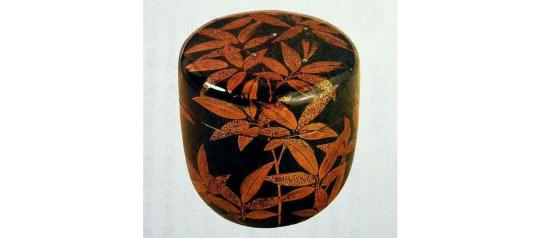
Together with this natsume, Rikyū would have used an ori-tame [折撓] as the chashaku, one that he had made by himself.

And, though also not mentioned in his kaiki, Rikyū most likely used a take-wa [竹輪] as the futaoki, and a mentsū [面桶] as the mizu-koboshi.

___________
*It seems that the gathering had been originally planned for Mōri Terumoto alone. Then three other guests came and asked to be allowed to participate. Rikyū probably served Terumoto a personal bowl of koicha, and then offered a second bowl of koicha to the others (as sui-cha [吸い茶], meaning that a single bowl of koicha was shared by these three guests), followed by usucha.
⁸Shakuhachi ni baika ireru [尺八に梅花入る].
As before, this was the oki-hanaire [置き花入] named “Shakuhachi” [尺八] that Rikyū had made for the all-night flower-arranging competition that Hideyoshi had hosted during the siege of Odawara the previous summer.

Placed on an usu-ita [薄板] on the floor of the tokonoma, the effect would have been similar to that of the previous day.
⁹Ato ni Hashi-date deru [後に橋立出る].
Hashi-date [橋立] was Rikyū’s best cha-tsubo. It was taken to the island of Shikoku not long after his death, and vanished from the records (and so was presumed lost) during Sen no Sōtan’s lifetime (according to a document written by Sōtan that discusses the fates of Rikyū’s three cha-tsubo).
In Rikyū’s period it was customary for the guests to have an interest in examining the cha-tsubo, since this also revealed the source of the tea that it contained. (In this period, the tea jars were usually filled by tea merchants, who acquired the leaf tea from the growers, and then blended it in order to achieve a more consistent product from year to year.)
¹⁰Tai no yaki-mono [鯛のやき物].
Tai [鯛] (sea bream) grilled over charcoal. It was basted with salted water while it cooked.
¹¹Koi no sashimi [こいのさしみ].
This refers to what is now known as koi arai [鯉洗い]: the carp was cleaned and filleted, and the fillets were placed in a bath of hot water before they were transferred to cold water (to chill and firm the flesh). After chilling, the fillets were carved into bite-sized pieces, as usual for sashimi.
¹²Imo-no-kuki ・ azuki irete [no] shiru [いものくき・小豆入テ汁].
This is a kind of miso-shiru, in which imo-no-kuki and cooked azuki beans are suspended.
Imo-no-kuki [芋の莖, 芋の茎]* are the petioles of the taro plant. These were eaten as a vegetable in early spring†, when the plants first begin to sprout. Care must be taken to remove the stringy vascular bundles from the concave side of the petiole before cooking. They are boiled lightly, but should still be fairly crisp when served.
Azuki [小豆] are small, burgundy-colored beans. They are best known to foreign practitioners of chanoyu as being one of the main ingredients in many types of wa-gashi [和菓子] (Japanese traditional sweets -- though the word is generally used to refer to kashi specifically made for chanoyu), but, in fact, they are also used as a vegetable, as here.
___________
*More commonly known as zuiki [ずいき = 芋茎] today.
†They could, of course, be eaten at any time. But it was in the early spring, when fresh vegetables were still scarce, that imo-no-kuki were most commonly included in the diet.
The petioles of the sweet potato plant (not the vines) can be eaten in the same way, and sometimes the name imo-no-kuki is used for these as well.
¹³Meshi [めし].
Steamed rice.
¹⁴Hakuchō no shiru [白鳥ノ汁].
This is a clear soup -- perhaps served more as a stew (in other words, with a larger proportion of meat and vegetables than when offered as a soup course) -- made by boiling the flesh and bones of a wild swan, together with pieces of daikon and seasonal vegetables.
The swan would have been provided to Rikyū by Hideyoshi’s hawkers.
¹⁵Fu-no-yaki [ふのやき].
Rikyū’s signature wheaten crêpes, spread with sweet white miso (or possibly miso-an [味噌餡] -- which is the same white miso diluted with strained cooked white beans) before being rolled or folded into bite-sized pieces.
¹⁶Yaki-guri [やき栗].
Roasted chestnuts.
¹⁷Sase Yosozaemon [佐世與三左衞門].
This refers to the bushō [武将] (military man) and daimyō Sase Motoyoshi [佐世元嘉; 1546 ~ 1620], who was a personal retainer of Mōri Terumoto. Motoyoshi served as Governor of Iwami (Iwami-no-kami [石見守]), and also Governor of Nagato (Nagato-no-kami [長門守]), both in the far west of the main Japanese island of Honshū, with the latter position including responsibility for guarding the Kanmon Straits.
Sase Motoyoshi and Hayashi Narinaga were both Mōri Terumoto’s personal attendants -- perhaps equivalent to his personal guard of honor.
¹⁸Hayashi Hizen-no-kami [林肥前守].
This is a reference to Hayashi Narinaga [林就長; 1517 ~ 1605], another personal retainer of Mōri Terumoto, who was a daimyō-nobleman* in his own right.
The Hisada-bon [久田本] refers to this man as Hayashi Higo-no-kami [林肥後守], meaning he was the Governor of Higo, but this is clearly an error -- since a member of the Hayashi family did not serve as governor of that province until the late Edo period. Possibly this suggests that portions of the Hisada-bon were modified later.
___________
*As Governor of Hizen (Hizen no kami [肥前守]), Hayashi Narinaga held the junior grade of the Fifth Rank.
¹⁹Shōan rō [少安老].
This probably refers to Mozu-ya Sōan [萬代屋宗安; ? ~ 1594]*, who appears to have been close to Rikyū’s own age (perhaps a year or two younger, as attested by the affectionate use of the kanji “shō” [少]) -- and who has been seen in the role of batsu-kyaku [末客] (last guest)/hantō [半東] (host’s assistant) at other chakai where the other guests were high government officials or noblemen. Sōan’s name was also written as Shōan/Sōan [variously as 少安, 小安, 少庵, and 小庵], by his contemporaries†.
I should mention that the Sadō Ko-ten Zen-shu‡ identifies this person (without further explanation, or justification) as [Miyaō] Sōjun [(宮王)宗淳; 1546 ~ 1614], the son of Miyaō Saburō Sannyū [宮王三郎三入; ? ~ 1582], who is usually known today as Sen no Shōan [千少 庵]. But this argument is extremely problematic, if only because (in addition to the fact that the second kanji for his name is different -- and this difference has nowhere been accounted for) the suffix rō [老] (which means “old man**”) would not have been appropriate for a man 45 years of age, who was younger than everybody else participating at this gathering with the exception of the shōkyaku (and even here the age-difference was not sufficient to elicit this sort of honorific, were “Shōan” actually a member of Terumoto’s party -- rather than someone whom Rikyū had called upon to help him in a pinch as I have suggested).
___________
*While Mozu-ya Sōan’s date of birth is not known with certainty, the indications are that he was the same age (or a year or two younger) than Rikyū himself. While there was no fixed rule, the honorific suffix rō [老] was not generally used for people under 60 years of age.
†Which has played into the hands of scholars who want to assert a closer connection between Miyaō Sōjun, who was also known as Shōan [少庵] (though it seems, mostly in later accounts), and Rikyū. In fact, it is difficult to associate Miyaō Saburō Sannyū’s son with most of these references (which is why they are rarely mentioned in public), while the more likely person is always Mozu-ya Sōan.
Mozu-ya Sōan was one of Rikyū’s closest personal friends, and it would be to such a person that he would turn when he needed help serving important guests (as here), rather than the son of his second wife (whom he had married on Hideyoshi’s orders around 1585 or ’86, and to whose son he had barely been introduced -- a son who practiced a form of machi-shū chanoyu far removed from Rikyu’s own style).
‡Published by Tankōsha [淡交社], whose affiliated scholars can always be relied upon to promote Urasenke’s version of chanoyu and its history.
**The suffix ro [老] also includes the nuance that the person so designated was what we might call an “elder” -- that is, in the context of chanoyu, a publicly respected master (what Yamanoue Sōji called a chanoyu-sha [茶湯者], a man who made his living as a teacher of tea, and who was publicly acknowledged and respected as such). Mozu-ya Sōan was, in fact, employed as one of Hideyoshi’s tea masters (and apparently part of his responsibility was to act as an instructor for Hideyoshi’s courtiers, and possibly his women); Sen no Shōan, on the other hand, does not seem to have cultivated much of a public persona -- and he (and his son Sōtan) seem to have curtailed all of their public activities, and literally went into hiding after Rikyū’s seppuku (a situation from which Sōtan only emerged in his later years, and only after much prodding by the Tokugawa bakufu).
²⁰Hiroma [廣間].
The 18-mat “Colored Shoin,” the main reception room in Rikyū’s Juraku-tei residence.
The guests would have had to exit the building and cross the garden to reach the (detached) 4.5-mat yashiki.

Two of the men may have been attendants of Mōri Terumoto, and were served their meal separately -- perhaps because their presence had not been anticipated by Rikyū. Shōan, meanwhile, was a personal friend of Rikyū‘s, who likely participated in order to help Rikyū serve the others*.
___________
*As Rikyū could not be in two places at the same time, Shōan may have helped with the food service in the shoin, while Rikyū waited on Lord Terumoto in the 4.5-mat room.
Nevertheless, the fact that Shōan also drank tea during the go-za together with the others suggests that he was not simply an assistant.
²¹After the naka-dachi, the three other “guests” followed Lord Terumoto when he returned for the go-za.
Possibly they joined him at the koshi-kake.
4 notes
·
View notes
Photo

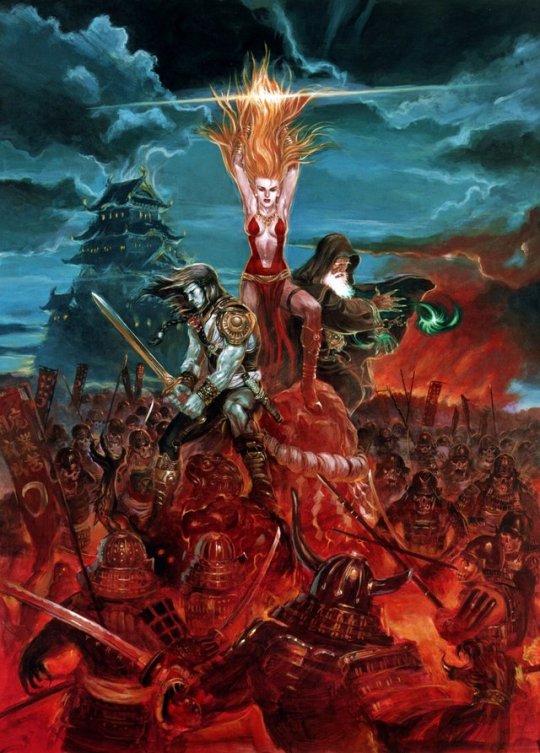
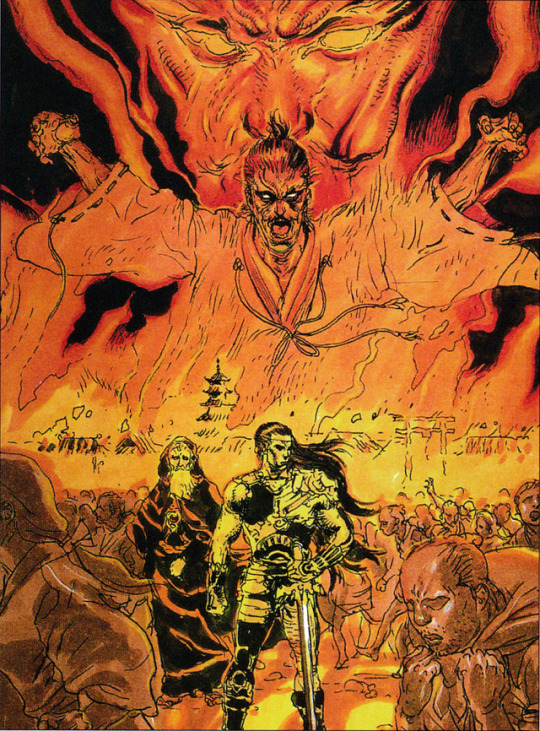







Katsuya Terada / 寺田 克也 - Part 1: 1987-1993
http://cacazan.com/
http://katsuyaterada.tumblr.com/
https://www.facebook.com/katsuya.terra.terada
Terada has worked on about 50 games in the past 30 years. He became famous in the West in the early 2000s with the release of the movie Blood: The Last vampire for which he designed the main characters, his cover girls and his huge artbook "Rakugaking".
Paradoxically, nowadays , outside of Japan, his name is more often attached to the Zelda series, one of his earliest works -- from 1989 to 1995, he was a regular contributor to the North American magazine Nintendo Power for which he did many artworks, including illustrations for Link's Awakening and A Link to the Past. On a related note, some of his Link's Awakening artworks seem to be exclusive to the official German player's guide.
Games pictured above:
1) Tantei Jingūji Saburō - Shinjuku Chūō Kōen Satsujin Jiken / 探偵神宮寺三郎 新宿中央公園殺人事件 (FDS - 1987)
2-5) Sorcerian System Scenario Vol. 2: Sengoku Sorcerian / 戦国ソーサリアン (PC-88 - 1988)
6) Tantei Jingūji Saburō - Yokohama-kō Renzoku Satsujin Jiken / 探偵 神宮寺三郎 横浜港 連続殺人事件 (Famicom - 1988)
Tantei Jingūji Saburō - Kiken na Futari Zenpen / 探偵神宮寺三郎 危険な二人 前編 (FDS - 1988)
Tantei Jingūji Saburō - Kiken na Futari Kōhen / 探偵神宮寺三郎 危険な二人 後編 (FDS - 1989)
Tantei Jingūji Saburō - Toki no Sugiyuku Mama ni... / 探偵 神宮寺三郎 時の過ぎゆくままに… (Famicom - 1990)
7) Blue almanac / ブルーアルマナック, AKA Star Odyssey (Mega Drive - 1991)
8) Prince of Persia / プリンスオブペルシャ (SFC - 1992)
9) Final Fantasy Mystic Quest, AKA Final Fantasy USA: Mystic Quest / ファイナルファンタジーUSA ミスティッククエスト (SNES - 1992)
10) Bishin Densetsu Zoku / 美神伝説Zoku Bishin Densetsu Zoku / Zoku: The Legend of Bishin (SFC - 1993)
Games he has worked on:
Note: I omited a few games such as Tekken 5 Dark Resurrection, Culdcept II: Expansion and Culdcept 3DS which reuse designs/card illustrations from earlier games.
Alteil / アルテイル (browser game - 2004) card illustrations and chara design for 4 EX Villains
Battle K-Road / バトルクロード (Arcade - 1994) character illustrations
Bishin Densetsu Zoku / 美神伝説Zoku Bishin Densetsu Zoku / Zoku: The Legend of Bishin (SFC - 1993) cover art, illustrations
Blue almanac / ブルーアルマナック, AKA Star Odyssey (Mega Drive - 1991) cover art, manual illustrations
Busin: Wizardry Alternative, AKA Wizardry: Tale of the Forsaken Land (PS2 - 2001) chara-design, illustrations, cover art
Cristopher Columbus / クリストファー・コロンブス (SFC - ~1993 - canceled) illustration
Culdcept II / カルドセプト セカンド (Dreamcast - 2001) card illustrations (with others)
Culdcept Saga / カルドセプト サーガ (Xbox 360 - 2006) card illustrations (with others)
Dual Heroes / デュアルヒーローズ (N64 - 1997) character illustrations, in-game illustration, "Virtual Gamer Design"
Fate/Apocrypha / フェイト/アポクリファ (cancelled MMO - year unknown but the project was covered by a book published in June 2011) chara-design for 2 characters (Berserker and Lancer)
Final Fantasy Mystic Quest, AKA Final Fantasy USA: Mystic Quest / ファイナルファンタジーUSA ミスティッククエスト (SNES - 1992) manual illustrations (North American version)
Final Fantasy XI / ファイナルファンタジーXI (PS2, PC - 2005) promotional illustration featured on postcards available at the FFXI Summer Carnival 2005.
Final Fantasy XI Tsuika scenario "Ishi no Miru Yume" / ファイナルファンタジーXI追加シナリオ 『石の見る夢』, AKA Final Fantasy XI Additional scenario: A Crystalline Prophecy (PS2, PC, Xbox 360 - 2009) illustration
Galak-Z: The Dimensional (Windows, Mac, Linux - 2015) enemy-designs (with others)
Kengō 2 / 剣豪2 (PS2 - 2002) cover art, illustrations, chara-design
Kitakata Kenzou Sangokushi / 北方謙三 三国志 (PS2 - 2001) Cover art, illustrations
Knights Contract / ナイツコントラクト (PS3, Xbox 360 - 2011) promotional illustration
La-Mulana EX (PS Vita - 2014) Illustration
Lord of Vermilion / ロード・オブ・ヴァーミリオン (Arcade - 2008) card illustration x1
Maten Densetsu: Senritsu no Ooparts / 魔天伝説 戦慄のオーパーツ (SFC - 1995) chara design, illustrations, cover art
Nanatama: Chronicle of Dungeon Maker / 七魂 クロニクルオブダンジョンメーカー (PSP - 2009) cover art, illustrations, chara design
Onimusha Soul / 鬼武者Soul (browser game - 2012) chara-design (Tokugawa Ieyasu, Takeda Shingen)
Prince of Persia / プリンスオブペルシャ (SFC - 1992) cover art
Ryūteki go sennen: Dragons of China / 龍的五千年 Dragons of China (Saturn - 1997) Chara-design
Sangokushi Taisen / 三国志大戦 (Arcade - 2005) card illustration x1 (EX005 Zhang Liao)
Seifū no Kyōshikyoku: The Rhapsody of Zephyr / 西風の狂詩曲 (Windows - 1999) cover art
Sengoku Efuda Yūgi Hototogisu Ran / 戦国絵札遊戯 不如帰 -HOTOTOGISU- 乱 (PSP - 2008) card illustrations (with others)
Sengoku Efuda Yūgi Hototogisu Tairan / 戦国絵札遊戯 不如帰 -HOTOTOGISU- 大乱 (PSP - 2010) card illustrations (with others)
Sengoku IXA / 戦国IXA (browser game - 2010)
Simple 2000 series Ultimate Vol. 12: Street Golfer / SIMPLE2000シリーズ アルティメット Vol.12 ストリートゴルファー (PS2 - 2003) illustrations, chara-design
Sol Divide / ソルディバイド (Arcade - 1997) illustrations, chara design
Sorcerian System Scenario Vol. 2: Sengoku Sorcerian / 戦国ソーサリアン (PC-88 - 1988) cover art, illustrations
Tantei Jingūji Saburō - Early Collection / 探偵 神宮寺三郎 アーリーコレクション (PS1 - 1999) cover art, illustrations, chara-design
Tantei Jingūji Saburō - Ghost of the Dusk (3DS - 2017) cover art
Tantei Jingūji Saburō - Innocent Black / 探偵 神宮寺三郎 Innocent Black (PS2 - 2002)
Tantei Jingūji Saburō - Kiken na Futari Kōhen / 探偵神宮寺三郎 危険な二人 後編 (FDS - 1989) cover art, illustrations, chara-design
Tantei Jingūji Saburō - Kiken na Futari Zenpen / 探偵神宮寺三郎 危険な二人 前編 (FDS - 1988) cover art, illustrations, chara-design
Tantei Jingūji Saburō - Kind of Blue / 探偵 神宮寺三郎 Kind of Blue (PS2 - 2004) original chara-design, illustrations
Tantei Jingūji Saburō - Mikan no Rupo / 探偵神宮寺三郎 未完のルポ (PS1, Saturn - 1996)
Tantei Jingūji Saburō - Shinjuku Chūō Kōen Satsujin Jiken / 探偵神宮寺三郎 新宿中央公園殺人事件 (FDS - 1987) cover art, illustrations, chara-design?
Tantei Jingūji Saburō - Toki no Sugiyuku Mama ni... / 探偵 神宮寺三郎 時の過ぎゆくままに… (Famicom - 1990) illustration, original art
Tantei Jingūji Saburō - Tomoshibi ga Kienu Ma ni / 探偵神宮寺三郎 灯火が消えぬ間に(PS1 - 1999)
Tantei Jingūji Saburō - Yokohama-kō Renzoku Satsujin Jiken / 探偵 神宮寺三郎 横浜港 連続殺人事件 (Famicom - 1988) cover art, illustrations, chara-design
Tantei Jingūji Saburō - Yume no Owari ni / 探偵神宮寺三郎 夢の終わりに (PS1, Saturn - 1998)
Tekken 5 / 鉄拳5 (PS2 - 2005) extra costume designs x3 (Ling Xiaoyu, Raven, Ganryu)
Tekken Tag Tournament 2 / 鉄拳タッグトーナメント2 (PS3, Xbox 360 - 2012) extra costume design (Kunimitsu)
Virtua Fighter / バーチャファイター (Arcade - 1993) illustration
Virtua Fighter 2 / バーチャファイター2 (Arcade - 1994) illustrations (later reused for Virtua Fighter Remix)
Virtua Fighter Remix / バーチャファイターRemix (Saturn - 1995) cover art
+ an untitled unreleased game for which he designed the characters
To be confirmed:
Lunatic Dawn / ルナテックドーン (illustration featured in Zenbu, probably a fanart)
Marvel Trading Card Game (DS, Windows, PSP - 2007) maybe the game reuses pre-existent illustrations
Optical Axis / オプティカル アクシス (line art dated 1992, not sure if it's a game)
I don't know if Terada has worked on the Tantei Jingūji Saburō series since the PS2 episodes, apart from the recent 3DS game for which he created the main illustration. Of course, since he designed the main characters of the series, he is probably credited in some if not all of these games.
Tantei Jingūji Saburō - Akai Chō / 探偵 神宮寺三郎 赤い蝶 (DS - 2010)
Tantei Jingūji Saburō - Fukushuu no Rinne / 探偵 神宮寺三郎 復讐の輪舞 (3DS - 2012)
Tantei Jingūji Saburō - Fuserareta Shinjitsu / 探偵 神宮寺三郎 伏せられた真実 (DS - 2009)
Tantei Jingūji Saburō - Hai to Diamond / 探偵 神宮寺三郎 ~灰とダイヤモンド~ (PSP - 2009)
Tantei Jingūji Saburō - Inishie no Kioku / 探偵 神宮寺三郎 いにしえの記憶 (DS - 2007)
Tantei Jingūji Saburō - Kienai Kokoro / 探偵 神宮寺三郎 きえないこころ (DS - 2008)
Tantei Jingūji Saburō - Shiroi Kage no Shōjo / 探偵神宮寺三郎 白い影の少女 (GBA - 2005)
Other video game related works:
Note: One of his Alteil illustrations is featured on the cover of the book Alteil~神々の世界『ラヴァート』年代記 オフィシャルガイド.
Arc System Works 25 Shūnen Kinen Kōshiki Character Collection / アークシステムワークス25周年記念 公式キャラクターコレクション (artbook - 2013) guest illustration
Assassin's Creed art Exhibition (exhibition - 2011) illustration
Dragon Quest 25th anniversary (2012) illustration
Fire Emblem : The complete / ファイアーエムブレム ザ・コンプリート (artbook - 1996) guest illustration
Gunbird / ガンバード () guest illustration featured in the artbook Psikyo Illustrations
KG Sengoku TURbuhā / KG 戦国TURぶはあ (book related to the Dreamcast game Sengoku Turb) illustration(s)
Sengoku Blade / 戦国ブレード () guest illustration featured in the artbook Psikyo Illustrations
The Legend of Zelda: A Link to the Past - Nintendo Player's Guide (Guide book - 1992) illustrations
The Legend of Zelda: Link’s Awakening - Der offizielle Nintendo Spieleberater (Guide book - 1994) illustrations for Zelda 1, 2 ALTTP and Link's Awakening
The Legend of Zelda: Link’s Awakening - Nintendo Player's Guide (Guide book - 1993) illustrations for Zelda 1, 2 and Link's Awakening
Virtua Fighter 2 Ten Stories / バーチャファイター2 テンストーリーズ (comics - 1997)
Nintendo Power contributions:
#1 July-August 1988 - Gauntlet
#3 November-Decermber 1988 - Ultima
#5 March-April 1989 - The Adventures of Bayou Billy (to be confirmed. Terada is not credited but the illustration has his distinctive art style)
#6 May-June 1989 - Dragon Warrior
#7 July-August 1989 - Dragon Warrior
#8 September-October 1989 - Dragon Warrior
#9 November-December - Dragon Warrior (Nintendo Power Strategy Guide)
#12 May-June 1990 - Crystalis
#12 May-June 1990 - Ninja Gaiden II
#15 July-August - Ninja Gaiden II (Nintendo Power Strategy Guide)
#16 September-October 1990 - Dragon Warrior II
#18 November-December 1990 - Castlevania III 1
#19 4 Player Extra - Gauntlet II
#21 February 1991- Ultima Quest of the Avatar
#23 April 1991 - Sword Master
#27 August 1991 - Dragon Warrior III
#30 November 1991 - Final Fantasy II
#31 December 1991 - Actraiser
#33 February 1992 - Ys III
#38 July 1992 - Magic Sword
#39 August 1992 - Contra Force
#41 October 1992 - Double Dragon 3
#45 March 1993 - Zen
#46 April 1993 - Dragon Warrior IV
#47 May 1993 - Koei
#52 September 1993 - Final Fantasy Legend III
#54 November 1993 - Ultima Runes of Virtue II
#59 April 1994 - X-Kaliber 2097
#62 July 1994 - Secret of Mana
#63 August 1994 - Secret of Mana
#64 September 1994 - Secret of Mana
#65 October 1994 - Illusion of Gaia
Sources:
Falcom Chronicle (Sorcerian, Seifū no Kyōshikyoku)
Fate/complete material IV Extra material (Fate/Apocrypha)
Psikyo Illustrations - Psi (Battle K-Road, Sol Divide, Sengoku Blade, Gunbird)
Rakugaking (Prince of Persia, Nintendo Power, Tantei Jingūji Saburō, Prince of Persia)
(p12, 18, 322, 357, 449-451, 496, 850)
Koko 10-nen / ココ10年 (Street Golfer, Knights Contract, Sengoku Efuda Yūgi Hototogisu Ran, Assassin's Creed, etc.)
Virtua Fighter Maniax
Zenbu (Nintendo Power, Dragon Warrior Strategy Guide, Blue Almanac, Dual Heroes, Sol Divide, Bishin Densetsu Zoku, Battle K-Road, Tantei Jingūji Saburō, 1 untitled game, Prince of Persia)
Alteil:
https://login.alteil.jp/al2CardDB/list.php
Busin
http://i.mtime.com/tmdmlgb/blog/3439230/
Culdcept series:
http://www.culdceptcentral.com/index.php
Final Fantasy XI:
https://www.famitsu.com/pcent/news/1220014_1341.html
http://elemen.jp/ff11/contents/goods/etc.html
Galak-Z
https://twitter.com/17_BIT/status/834692786096058368
Kengō 2
http://www.genki.co.jp/game/ps2/kengo2/02.php
Kitakata Kenzou Sangokushi:
http://game.watch.impress.co.jp/docs/20010615/mfac.htm
Mirai Ninja by Katsuya Terada
https://twitter.com/Yoshi6054/status/609579957988098049
Sangokushi Taisen
http://gr.qee.jp/02_st/st2/ex/ex05.html
Sengoku Efuda Yūgi Hototogisu Ran
http://game.watch.impress.co.jp/docs/20081010/irem.htm
Sengoku Efuda Yūgi Hototogisu Tairan
http://dengekionline.com/elem/000/000/271/271180/
Sengoku Ixa
http://game.watch.impress.co.jp/docs/news/384590.html
Tekken 5
http://game.watch.impress.co.jp/docs/20050318/tk5.htm
196 notes
·
View notes
Text
Underneath the Underneath [3/?]
Temporary Blanket Disclaimer
First Chapter
AN: Not edited yet. But it’s been written, which is half the battle :D
Manako Inuzuka sits cross-legged on the glass counter of the surplus shop, scowling down at the week’s ledger. She’s not a fan of numbers or mathematics at all, but even she can see that something is not quite adding up.
Which is bad, because when the numbers don’t add up, she gets the blame for it and ends up taking a pay cut somewhere.
And I already practically live on cup-ramen. If I eat any more of it, I’m gonna turn into that Uzumaki kid...
“Oi! What do you think you’re doing?!” a familiar voice demands, and Saburō Izumo hobbles in from the backroom, wrinkled face pulled tight in disapproval. Manako’s boss is a short, skinny old man with threadbare, iron grey hair that sticks out in every direction, and hands permanently stained and scarred from making explosives.
His favourite pastime is the glare at potential customers who linger in the shop without buying anything. When he’s in a particularly overbearing mood, he puts on a set of thick, round pince-nez glasses to magnify his unimpressed stare.
Since he’s not wearing them now, Manako decides he’s just in a complaining mood and not actually angry. She returns her attention to the ledger.
“How many times do I say? I don’t want your backside smudging up the display!” he scolds. “And what happens when you break the glass? You’re gonna die a horrible, agonizing death from blood loss, then I have to find replacement. The paperwork!”
“Relax, old man, I’ve got enough training to know how to channel chakra to my ass, it won’t break the glass,” Manako retorts, not looking up.
“Ungrateful whelp…No respect for your elders…”
She notices something out of the corner of her eye, and upon re-reading a line of numbers, smirks in triumph—she’s figured out why the numbers don’t look right.
“You’ve overpriced the gunpowder again,” Manako points out. “No one’s going to buy it here when down the street they’re practically giving it away.”
“They’re practically giving it away because it is cheap imitation,” Saburō harrumphs, striding over to tap the book in her hand. “This? This is secret recipe. Passed down to me by my father, who got it from his father, and so on for many generations of—”
“Important people who did important things and had no fun,” Manako cuts him off. “You say this every time, but I’m the one who has to look at the books, and the profit margin ain’t ever as high as you think it is.”
“Profit is profit. And if it’s more than what that old fishwife across town is making, that’s enough.”
“That…isn’t she your wife?”
“And I love her dearly,” Saburō says, tapping his heart with his fist. “But home is home and business is business and I will blow her quaint little stall out of the water.”
“Freaky old fool,” Manako says, unable to hold back a smile. “Fine. But you’re still getting ripped off by the guys selling you the powder. I can hook you up with better quality stuff, for much cheaper, if you’d just—”
“Oi!” he scowls at her over his glasses. “This legitimate business. None of your questionable connections here! At least wait until I’m dead and gone and with a nice memorial stone. Then you can run this place like the black market for all I care. But until then—” he shakes a finger at her, “—we are wholesome, family store!”
“Whose financial model is built around selling tools that kill people, with a side goal of destroying your wife’s business,” Manako deadpans.
“Exactly.”
She sighs and returns her attention to the books. “We’re out of the specialty metsubushi. Really popular with all those new Academy students that figure they should whip out the weapons for every little schoolyard fight. We should restock and raise the price. Ten percent?”
“Fifteen. Once the injuries start, sales will go down. Strike while the iron’s hot,” Saburō says gleefully.
And people say I’m devious, Manako thinks with a snort. “There were a bunch of kids eyeing the Exploding Spheres, too. We should institute a strict ‘chūnin and older’ policy, or we’re going to have Old Man Third after us about responsible selling.”
“Hmph. We’ll put up a sign. When you’re done with those, come in back, we can get started on the orders for tomorrow.”
“You said I could take the afternoon off,” Manako reminds him.
“Why?”
“Because I asked for it?”
“That doesn’t sound like me.”
“I know. That’s why when you said it, I checked to make sure you weren’t an imposter using Henge and then made you sign a release form?” she prompts, producing a small, crinkled paper written on the back of a receipt.
Saburō leans in and studies it, as if trying to detect a forgery. “I…suppose this seems in order.”
“Oh, shut up, you know you said I could. You complained all day about it,” Manako rolls her eyes.
“Well, I don’t see why you need to go early. What’s more important than making sure you’re well prepared for tomorrow’s business?”
“I have a date.”
“So?”
“So, I haven’t been out in a while and need a break.”
“Why?”
Manako rolls her eyes. “Because young people—which, I’m pretty sure you used to be a long, long, long—”
“Oi!”
“—time ago, like to go out and have fun sometimes.”
“Young people didn’t have fun when I was your age. They were too busy fighting. And working. And being respectful.”
“Good thing we live now, and not then.”
“Hmph. It’s not that grocery boy again?” Saburō wants to know. “He’s not good enough for you.”
“Thanks, and no,” Manako retorts with false modesty. “It’s the girl at the bakery.”
He blinks. “The one who looks like Princess Gale?”
“Exactly.”
“Feh. That won’t end well,” Saburō shakes his head.
Manako crosses her arms and juts her chin out in challenge. “Are you saying she’s out of my league?”
“I say she’s the sort to make noise and get a person in trouble. And you—you’re the type that gets in trouble.” He pauses. “And yes. She’s out of your league.”
“Gee, thanks…”
“Maybe if you were more respectful girl…”
“Wrong Inuzuka.”
“You should ask that girl at that ramen stand. She’s much politer. Or one of those boys who guard the city gate.”
“Pretty sure those two are spoken for,” Manako replies, amused. “And Ayame doesn’t like girls.”
“Pity. She could bring us lunch if she visited you.”
“I love how my dating life is all about what you can get out of it…”
“I’m old. All that’s left is to live life vicariously through you. Even though you have terrible judgement.”
“Says the man getting ready to start a price war with his wife. I hope she makes you sleep on the couch.”
Saburō waves that off.
“Very well. Finish the books and you can go. I will go and prepare for tomorrow. All alone. Even though I have such terrible arthritis in my fingers these days,” he sighs loudly, heading into the back room.
“You’re not guilting me out of the first afternoon off I’ve had in a month,” Manako calls after him.
“You’ll feel bad when my hands cramp up and I can’t work anymore, and we lose the store,” he calls back. “Or at least when it turns out I’m right about that girl. Then you’ll say, ‘oh, I wish I had listened to Uncle Saburō, and stayed to do my work, because now I still have money and my heart isn’t broken’.”
“Try not to inhale anymore of the ingredients back there!” Manako shouts back, but he either doesn’t hear it or chooses to ignore it.
Crotchety old bugger, she thinks fondly as she goes back to the finances. It doesn’t take her long to finish checking the last tallies up, but just as she makes the final calculations, the door opens and closes. A beat later, her nose twitches at a familiar scent garlic, toad oil and sake—all barely hidden under a layer of artificial fragrance.
Someone’s been to an onsen recently, she thinks as a figure takes up residence in front of her. Closing the store ledgers, Manako leans forward, propping her chin on her palm to regard the tall, white-haired man before her.
“Hey there, Manako,” he drawls, the smile on his face sly despite how he shows all his teeth. “Have you turned eighteen yet?”
“Hey, Jiraiya,” she replies with an equally sly smile. “Have you contracted syphilis yet?”
The sage’s expression falls flat and he pouts at her. “You are a very unpleasant young woman.”
“And you’re a pervert who should be sterilized for the good of womankind.” She swivels around, hopping behind the counter. “And yet you’re a legend. The universe is funny like that. Nice sunglasses, by the way. Is that really how you sneak around the continent?”
“Hmph. Sunglasses are inconspicuous.”
“You can tuck your hair into your belt. Inconspicuous left the equation about thirty years ago.”
“Well, inconspicuous is overrated anyway. How else would I attract the attention of lovely ladies looking for love?” he smarms.
Manako wrinkles her nose.
“Gross, but points for the alliteration,” she says. “Are all the legendary Sannin as messed up as you?”
“Trust me, I have the least baggage,” Jiraiya grins, pretending to shoot two ‘finger guns’ at her.
“I don’t think you should sound so proud of that.”
“Well, you’re charming as ever,” he sighs. “Is your boss in?”
“I might be convinced to go find him for you if you offered the right incentive.”
“How about because it’s your job?”
“My job is to mind the front counter. If I go in back, how do I know you won’t steal something?”
Jiraiya frowns. “Would you just go and get the old man?”
“In a minute. You owe me something first.”
“Yeah, yeah…” he digs into his pocket and brings out a thick scroll. “Here are all my recommendations. Your devices work surprisingly well, and I’d be keen to bring a few more out with me.”
“Yeah?”
“Yes. The problem is there’s still no market for them in the big cities. The population in outskirts villages and the farmlands think they’re great, though. The farther out of the way, the more they like them.”
“Really?” Manako asks, brightening.
“Problem is, they can’t afford your asking price. So, unless you’re willing to donate a bunch just for exposure…”
“I can’t,” she protests. “They cost most of my paycheck to make!”
“Eh.” Jiraiya shrugs.
“Wait a minute—you mean you didn’t sell any? I didn’t give those to you for charity, you old badger!”
“Hey, watch the name calling! And what are you getting your nose all bent out of joint? You’re really angry I’m offering your product to people in need?”
“Well—no, but—I still gotta eat!”
“Then figure out a solution. Find a way to make them out of cheaper materials or something,” Jiraiya shrugs.
“Or people could just stop being terrible,” Manako grumbles.
“Then we’d all be out of a job,” Jiraiya says sagely, still digging into his pack. “But, failed business ventures aside, I’m not coming to you empty handed.” He drags out half a dozen paperbacks with lurid covers. “Here! The latest wonders from the distant lands.”
Manako lets out an undignified squeal that turns into rather maniacal laughter; luckily, no one is there to hear except Jiraiya. “Gimme!”
“Two of those are signed. I met the authors at a writer’s retreat in Kumo. Both ladies were…heh…more than happy to personalise those.”
Manako shoots him a suspicious look. “There aren’t any…stains I need to worry about on these, are there?”
“Don’t be crude, they’re in their original packaging!” Jiraiya yelps.
“Well, I just want to be sure,” Manako replies. “I’m not the only one reading this stuff, you know. I’ve got a friend who might want to read them after me, and I don’t want to explain why he might want to use gloves while handling them... He’s reading your latest now, though it’s taking him forever.”
“Hey, that was just for you,” Jiraiya complains. “If my publisher finds out your sharing my work before it’s even published yet…”
“Relax—the guy’s a jōnin. If he can be trusted with Konoha’s secrets, I doubt he’ll spill the ending of the latest Icha Icha,” she dismisses.
“Better not,” Jiraiya mutters.
“I’ve got a few things to say about that ending, though,” Manako goes on.
“Later. I’m on official business, which means your constructive criticism will have to wait.”
There’s something in his tone that informs her the time for joking is past. While Manako has never been one for blind respect, she also knows when it’s best to let a joke go.
“He’s in the back room.”
Jiraiya salutes and heads in back. “Stay weird, kid.”
“Not a problem,” Manako says, studying her stack of new books.
She suddenly has a dilemma in front of her.
Kimiko wouldn’t be that angry if I cancelled, right?
つづく
I had fun with this chapter. It’s been a while since I got to write snappy dialogue, and writing Manako I felt like I was channelling myself. I wish I had a boss like her, though…but hey, we got to see her at work, which is always fun ^_^
And yes, in case you missed the obvious, Manako is bisexual. Always has been, from when I first created her ( I have put hints about that in a few other fics...though I don’t know if anyone caught them ^_^)
Anyhow, hopefully this was a nice, lite bit of reading for you guys. It’s been so long since I had a moment to write anything, so I figured I’d start with light and humorous before I get back into the serious stuff. Next chapter we’ll see Kakashi again 😊 and get a little more Kakashi/Manako action. I just wanted to establish that they have entire lives without the other one in it before getting them into an acquaintanceship/friendship/romance.
Reviews and constructive criticism are appreciated! You can also find my tip jar here.
Next Chapter
栗
#naruto fanfic#inuzuka manako#manako inuzuka#jiraiya#sabouro izumo#original character#behind the scenes#character development#witty oneliners
14 notes
·
View notes
Note
Seeing those posts about childhood names, can you elaborate the naming system in Muromachi period?
In the West, we’re used to that the name you’re given at birth stays with you until you die. It’s the same in Japan now as well, but before the Meiji period it was different.
Now, this is only about the samurai class.
When you were born, you got a simple name. When you went through a ceremony proclaiming that you were an adult from then on (genpuku), you got an adult name, when you retired, you changed your name again to symbolize that you were a retired person. With a change of position, the name changed as well.
Childhood names were usually simple, often ending with “maru”, often including the word “matsu” (pine) or “chiyo” (thousand generations).
For example: Bontenmaru (Date Masamune), Benmaru (Sanada Nobushige/Yukimura), Saruyashamaru (Azai Nagamasa), Umatsu (Uesugi Kagekatsu), Toramatsu (Ii Naomasa), Takechiyo (Tokugawa Ieyasu), Shōjumaru (Kuroda Nagamasa) etc.
When you became an adult (there was no set age for becoming an adult, you had to go trough genpuku, which was usually between 12 to 16, but it could be earlier or later as well, Uesugi Kagekatsu went through genpuku at the age of 5, Ii Naomasa at the age of 21 - apparently), there were basically two names. One of them was a common name that other people used to refer to you, the other one was a real name.
The real names: Nobunaga, Masamune etc. These were only used when you were either dealing with the Emperor or signing official documents. The people weren’t called by these names. By that I mean that no vassal would ever call Nobunaga “Nobunaga-sama”, it was always some variation of “Uesama”, “Oyakatasama” or by the court title the person held. Enemies and non-vassals might use the real name if they didn’t feel like being polite.
Common names. There are several versions, one of them is a “numbered name”, so variations of Tarō, Jirō, Saburō, Shichirō, Gorō etc. Those simply mean first son, second son, third son etc.
For example: Oda Saburō (Nobunaga), Takeda Tarō (Shingen), Takeda Shichirō (Katsuyori), Mōri Shōnojirō (Motonari), Mōri Shōnotarō (Takamoto), Mōri/Kikkawa Shōnojirō (Motoharu), Mōri Shōnotarō (Terumoto), Tokugawa Jirōsaburō (Ieyasu) etc.
Another version were court titles. In Muromachi period, or rather in Sengoku Jidai period, the daimyō didn’t go through the Emperor and were giving their vassals “court titles” that became their common names. (Hideyoshi went through proper channels… I think)
For example: Naoe Yamashiro no kami* (Kanetsugu), Uesugi Danjōshōhitsu (Kagekatsu), Ishida Jibunoshō (Mitsunari), Sanada Saemonsuke (Nobushige), Takenaka Hanbee (Shigeharu) etc.
* Kanetsugu was known as Yamashiro no kami before the Uesugi surrendered to Hideyoshi.
“Names” ending with -bee/-bei, -emon, -suke etc. are names for official posts that had no meaning in Sengoku Jidai anymore and were used as common names. (Names ending with -emon were also common for the merchant class.)
The names such as Kojūrō, Heihachirō, Sakon, Ukon, Kiheiji, Kinosuke etc. are also common names.
In some cases you could be known by both: Oda Kazusanosuke Saburō Nobunaga.
When the samurai retired, it usually meant leaving the clan to enter the priesthood, or entered priesthood (they still lived with the clan though, in most cases), they would accept a Buddhist name.
For example: Kuroda Josui, Uesugi Kenshin, Takeda Shingen, Ōtomo Sōrin etc.
If a monk became a warrior, he would accept the name of the temple as their “surname” - Ankokuji Ekei.
Now, during the life, the samurai could change the lord they served, they could get adopted into another clan, their position became higher etc. and they changed their name as well.
For example: Nagao Kagetora (became adopted by the Uesugi clan) Uesugi Masatora (donated money to the Muromachi shogunate and received a kanji from the shogun Ashikaga Yoshiteru) Uesugi Terutora (became a monk) Uesugi Kenshin
The common name based on title could change as the person moved up in a hierarchy as well.
(Tokugawa) Mikawa no kami, (Tokugawa) Naifu, (Tokugawa) Ōgosho.
I hope it isn’t too confusing.
13 notes
·
View notes
Photo

Nobunaga Concerto Romaji: Nobunaga Kontseruto Japanese: 信長協奏曲 Director: Hiroaki Matsuyama Writer: Ayumi Ishii (manga), Masafumi Nishida, Michitaka Okada, Keisuke Uyama Network: Fuji TV Episodes: 11 Release Date: October 13 - December 22, 2014 Runtime: Mondays 21:00 TV Ratings: 12.5% (weekly average) Language: Japanese Cast Shun Oguri as Saburō/Oda Nobunaga/Akechi Mitsuhide Kō Shibasaki as Kichō Osamu Mukai as Ikeda Tsuneoki Takayuki Yamada as Hashiba Hideyoshi Gaku Hamada as Tokugawa Ieya Arata Furuta as Matsunaga Hisahide Taisuke Fujigaya as Maeda Toshiie Kiko Mizuhara as Oichi Masahiro Takashima as Shibata Katsuie Saburo adalah seorang murid SMU biasa, suatu hari dia terdampar ke tahun 1549. Saburo bertemu dengan Nobunaga Oda yg berwajah sama percis dengannya. Nobunaga adalah putra sulung dari seorang panglima perang. Karena banyaknya orang yg mau bunuh Nobunaga, jadi Nobunaga memilih untuk pergi dan menjauh dari keluarganya untuk sementara. Perebutan kekuasaan antar saudara? Nobunaga memilih untuk bertukar tempat dengan Saburo Bagaimana akhirnya Saburo melewati masa perang tahun 1549 Bagaimana akhirnya Nobunaga jadi di sukai oleh semua anak buahnya? Shun oguri sebagai murid SMU? Ketuaan Sejarah yg benar adalah nobunaga adalah seorang pemimpin yg kejam (Buka2 sejarah dari game Onimusha dan lainnya yg musuhnya Nobunaga) Tapi nobunaga yg ini lembek, sama istrinya aja takut Bingung kok bisa anak SMU ikut perang? Gak di ceritain juga ada frequency yg ngebikin Saburo terdampar ke masa lalu
2 notes
·
View notes
Text
Arc System Works have announced that their detective mystery game Alternate Jake Hunter: Daedalus The Awakening Of Golden Jazz has released on Nintendo Switch and PS4 today in North America. The game is a prequel to the Jake Hunter series and follows the game’s protaganist Saburoo Jinjuji as he travels to thee United States to uncover the truth of his grandfather’s death.
You can find out more about Alternate Jake Hunter: Daedalus The Awakening Of Golden Jazz below.
A thrilling murder mystery set against the backdop of New York City
Alternate Jake Hunter: DAEDALUS The Awakening of Golden Jazz is available today on PlayStation 4 and Nintendo Switch
Rolling Hills Estates, California – May 23, 2019 – Arc System Works America, Inc. is thrilled to announce that Arc System Works’ crime thriller, Alternate Jake Hunter: DAEDALUS The Awakening of Golden Jazz, a prequel to the Jake Hunter series of games is available today in North America (US, Canada, Mexico) on the PlayStation®Network for the PlayStation®4 and Nintendo Switch eShop. The Steam (PC) version will be available at a later date.
In the wake of the death of his grandfather, Saburo Jinguji heads to the United States to uncover the truth. Utilizing a new 360 degree investigation mode, Alternate Jake Hunter: DAEDALUS The Awakening of Golden Jazz blends true detective work like interrogations and clue-finding with unique storytelling elements to deliver a thrilling murder mystery.
RETURN OF A LEGEND – Hirotaka Inaba, the Scenario Writer of Tantei Jingūji Saburō: Yume no Owari ni (At the End of the Dream) released in 1998, returns to write the scenario for “Awakening of Golden Jazz”
TIME IS UNDER YOUR CONTROL – Switch between the different stages of Saburo’s life as you piece together clues and solve mysteries.
360 DEGREE SLEUTHING – Utilize a full 360 degree rotation with your surroundings, making searching for clues truly immersive.
UNIQUE VISUAL FLAIR – A visually arresting watercolor look merged with realistic video images combine to form a unique design.
STANCE CHANGE SYSTEM – Read and interact with the other person’s expressions and emotions to uncover the truth.
TREE OF THOUGHT – Visualize your own thoughts, organize and search for evidence, and pull testimony. As your information grows, your tree will “bear fruit”.
SHARPEN YOUR SENSES – Your “Sharpened Five Senses” allows you to visualize clues in unique ways.
STYLISH CHARACTER MODELS – Illustrator Zennosuke brings character visuals like no other!
#gallery-0-5 { margin: auto; } #gallery-0-5 .gallery-item { float: left; margin-top: 10px; text-align: center; width: 25%; } #gallery-0-5 img { border: 2px solid #cfcfcf; } #gallery-0-5 .gallery-caption { margin-left: 0; } /* see gallery_shortcode() in wp-includes/media.php */
DETAILS
Title: Alternate Jake Hunter: DAEDALUS The Awakening of Golden Jazz
Release: May 23, 2019
Developer: Neilo Inc.
Publisher: Arc System Works
Platforms: PlayStation 4 (Digital Release), Nintendo Switch (Digital Release), [Steam (PC) Release Date TBD]
Players: 1
Genre: Mystery/Adventure Visual Novel
Price: $39.99 USD
Voice Language: Japanese
Text Language: English
Region Availability: US, Canada, and Mexico
Source: Strangely Compelling PR
Alternate Jake Hunter: DAEDALUS The awakening Of Golden Jazz Out Now On Switch Arc System Works have announced that their detective mystery game Alternate Jake Hunter: Daedalus The Awakening Of Golden Jazz
#Alternate Jake Hunter: Daedalus The Awakening Of Golden Jazz#Arc System Works#Daedalus The Awakening Of Golden Jaz#Gaming#Neilo Inc#Nintendo#Nintendo Switch#videogames
0 notes
Text
Appendix: the Rikyū Hyakkai Ki, Part 26: (1591) Intercalated First Month, Third Day, Midday.
86) The Same, Midday of the Third Day¹.
○ Two-mat room².
○ Itami-ya ・ Jōmu [伊丹屋・紹無]³, Kome-ya ・ Yojūrō [米屋・與十郎]⁴, the same ・ Dōtsū [同・道通]⁵, Mozu-ya ・ Sōan [もずや・宗安]⁶.
○ Chaire ・ ko-natsume [茶入・小なつめ]⁷;
◦ Bizen tsubo [びぜんつぼ]⁸;
◦ Yoku-ryō-an bokuseki [欲了庵墨跡]⁹.
○ After tea was finished¹⁰:
◦ Kōrai-zutsu [かうらい筒], [with] plum blossoms [arranged] in it¹¹.
○ The feast was served in the large room¹².
○ Ko-tori senba-iri [小鳥せんば入]¹³;
◦ konowata [このわた]¹⁴;
◦ fukuto-jiru [ふくと汁]¹⁵;
◦ meshi [めし]¹⁶.
○ Kashi [菓子]:
◦ fu-no-yaki [ふのやき]¹⁷;
◦ yaki-mochi [やき餅]¹⁸.
_________________________
¹Onaji mikka no hiru [同三日之晝].
Onaji [同] refers to the month -- it is still the Intercalated First Month of Tenshō 19.
²Nijō shiki [二疊敷].
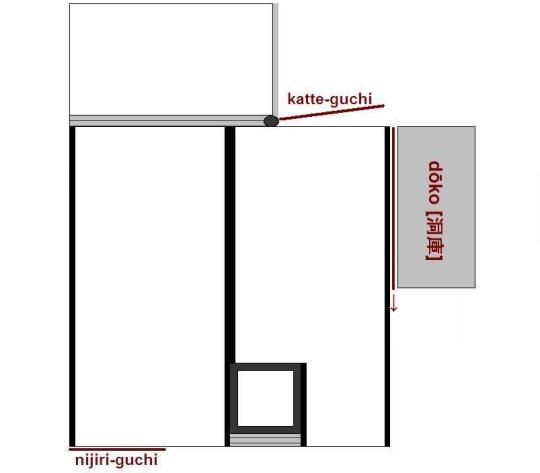
³Itami-ya ・ Jōmu [伊丹屋・紹無].
Itami-ya Jōmu [伊丹屋・紹無], who was also known as Shin-ho-an Jōmu [心甫庵 紹無], was a chajin from Sakai.
The Itami-ya [伊丹屋] house later became prominent after the rise of kabuki [歌舞伎] in the Edo period -- though it is possible that they were already associated with the performing arts (perhaps Nō [能]*, in which Hideyoshi also had a great interest) during this period.
___________
*Since the Ashikaga period, Nō [能] interpretations had frequently been more energetic than what came to be preferred later (in the Edo period). In a very real sense, Kabuki arose out of this more active form of the performance art, while leaving the classical (and sedate) themes to the -- by then -- archaic Nō.
That other famed nō actor of this period, Miyaō Saburō Sannyū [宮王三郎三入; ? ~ 1582] -- who fathered the line that became the "officially recognized" Sen family not long before Hideyoshi's own death -- was also an intimate of Hideyoshi (and, indeed, it was Sannyū's self-sacrifice at the battle of Yamazaki, where he literally intercepeted a bullet that had been aimed at Hideyoshi, which earned him and his son the undying thanks that permitted Hideyoshi to reinstate the Sen family name, under Sannyū's son Shōan, several years after Rikyū's death in ignominy).
⁴Kome-ya ・ Yojūrō [米屋・與十郎].
A wealthy machi-shū based in Kyōto* (the Kome-ya firm was involved in the rice trade – which apparently included the exchange of the samurai’s rice stipends for cash), the details of whose life have been lost.
Yojūrō was mentioned earlier in the Rikyū Hyakkai Ki, as a guest at the ato-mi that followed Rikyū's morning chakai on the 11th day of the Twelfth Month of Tenshō 18.
___________
*Apparently in the Shimo-gyō [下京] part of the city near Shichi-jō [七条] (Seventh Avenue).
The block where the firm was located is still known as Komeya-machi [米屋町].
⁵Onaji ・ Dōtsū [同・道通].
Onaji [同] here refers to the yagō [屋號]: in other words, Dōtsū was also a member of the Kome-ya house -- perhaps Yojūrō's brother or cousin; but nothing is actually known about him*.
___________
*There was a man from a military family who lived during this period named Inaba Michitō [稲葉道通; 1570 ~ 1608] (Michitō [道通] is another way to read the name Dōtsū [道通]). He was a daimyō and nobleman (junior grade of the Fifth Rank), who served as an imperial chamberlain of the left division (sakon no kurōdo [左近蔵人]). But given the person's position during the chakai (third guest), and the status of his fellow guests (all machi-shū), it does not seem that this individual can be identified with Michitō.
⁶Mozu-ya ・ Sōan [もずや・宗安].
Mozu-ya Sōan [萬代屋・宗安; ? ~ 1594] was one of Rikyū’s lifelong friends (they were perhaps of a similar age, though the details of Sōan's early life seem to have been lost), as well as the husband of one of Rikyū’s daughters. He was also numbered among the tea masters from Sakai who was employed in an official capacity in the tea department at Juraku-tei, and enjoyed a good reputation in chanoyu among his contemporaries.
⁷Chaire ・ ko-natsume [茶入・小なつめ].

The use of this tea container “says” that the tea served during this chakai was ground specifically for this gathering* (rather than being left over from the morning chakai).
The natsume would have been tied in a shifuku.
Rikyū appears to have abbreviated his record of this chakai†, since other utensils would have been needed to serve tea to his guests. Surely, the rest of the tori-awase would have been the same things that he used at the morning gathering that preceded this one:
◦ arare-gama [霰釜];
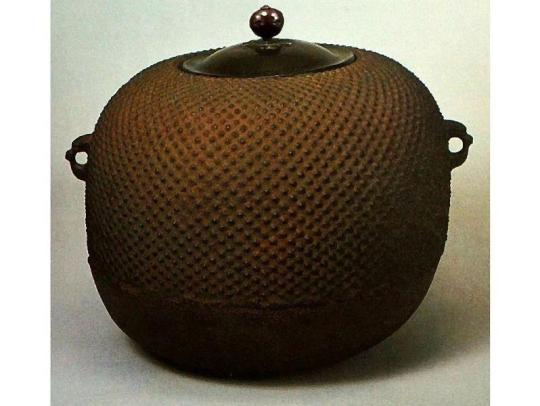
◦ Seto mizusashi [瀬戸水指];
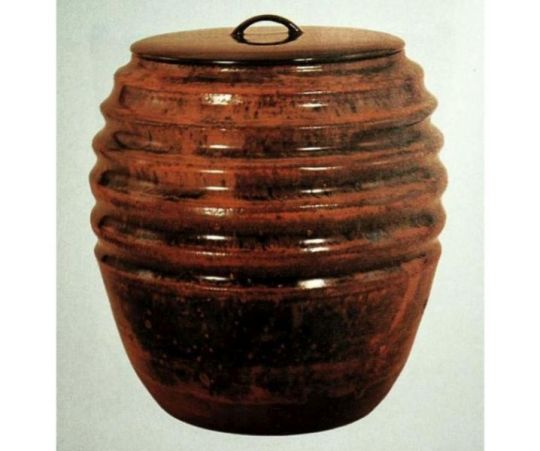
◦ Ko-mamori chawan [木守茶碗];

◦ ori-tame [折撓];

◦ take-wa [竹輪];

◦ hirai Shigaraki mizu-koboshi [平い信樂水飜]‡.

__________
*In other words, Rikyū ground the tea after the first chakai was over, the ko-natsume indicating that this was all the tea he was able to grind in the time between the end of the morning gathering and the end of the naka-dachi for the midday gathering.
†Suggesting that he was pressed for time. Perhaps this group of machi-shū had some reason to confer with Rikyū (certainly as the date for Hideyoshi’s upcoming invasion of the continent approached, the business community -- which provided much of the financing for the venture -- would have been concerned about updates) would have, and asked to meet him on the spur of the moment. Rikyū would have been one of the main intermediaries between the Sakai- and Kyōto-based machi-shū and Hideyoshi’s court at Juraku-tei.
‡It is also possible that he used a mentsū [面桶] as the koboshi, in the interests of purity.

⁸Bizen tsubo [びぜんつぼ].

⁹Yoku-ryō-an bokuseki [欲了庵墨跡].

¹⁰Cha sugite [茶すぎて].
Cha sugite [茶過ぎて] means “after the [service of] tea had been concluded.”
Precisely why Rikyū may have opted to wait to arrange the flowers until a point near the end of the chakai is not clear. Perhaps the sentence is a mistake? (In other words, perhaps Rikyū intended to indicate that the hanaire was added to the scroll -- suspended on the outer-wall-side pillar, and either miswrote or his words were not transcribed accurately. See footnote 12, below, for another indication that there may have been problems with this entry.)
¹¹Kōrai-zutsu ・ baika ireru [かうらい筒・梅花入].

The Kōrai-zutsu [高麗筒] was a kake-hanaire [掛け花入]. It seems that Rikyū may have suspended it on the pillar, while leaving the scroll hanging as it was.

Contrary to modern practices, if a kake-hanaire was not suspended on the wall at the back of the toko, it was hung on the minor pillar in the outer wall side of the toko (whether hung on the pillar, or on the bokuseki-mado as Furuta Sōshitsu did*, the idea was to suggest that the flower was growing outside in the garden, and simply leaning into the room: the flower always should arch toward the temae-za, regardless of where it is found).
Hanging the hanaire on the toko-bashira is a mistaken interpretation of the purpose of the hook that was sometimes (usually temporarily) nailed into that pillar at night gatherings: this hook was used to hang an oil lamp in the old days, the purpose of which was to illuminate the signature and name-seal(s) on the kake-mono (according to the classical teachings, the toko-bashira should always be located on the side of the scroll where the signature/seals appear). This hook was never used for the flower vase; and, indeed, it was usually removed completely after the gathering (since its position depended on the scroll -- if the host hung a different scroll at a subsequent night gathering, the location of the flame would have to be adjusted higher or lower accordingly). Unfortunately, the machi-shū did not understand this point, and, fearful of doing something wrong, they left the hook where the previous tea master had nailed it; and then conflated this hook with the other temporary hook that was sometimes nailed into the minor pillar (for the hanaire). The result is that, if the flowers are hung on the toko-bashira, it is impossible for them to have the correct orientation (leaning toward the temae-za).
___________
*Rikyū’s bokuseki-mado was usually located outside of the toko, behind the shōkyaku’s seat, making it impossible for him to hang the hanaire there. Suspending it on the minor pillar was equivalent to Oribe’s use of the bokuseki-mado for this purpose.
¹²Furu-mai hiroma ni te [振舞廣間にて].
Furu-mai [振舞] means a “feast” (i.e., a rather elaborate meal, served with some ceremony).

“In the large room” refers to Rikyū's 18-mat “Colored Shoin” -- which adjoined the 2-mat room through the 6-mat katte and 8-mat tsugi-no-ma [次の間] (as shown in the above sketch.
This statement, the language of which is rather odd (and atypical of Rikyū’s known usages) is not found in the Hisada family’s version of the Rikyū Hyakkai Ki. Since it was not usual for people making copies to add anything to the text, this suggests that this section of Rikyū‘s manuscript may have been in a poor state of preservation, or else Rikyū wrote something and then scratched it out (and the statement furu-mai hiroma ni te was someone’s guess at what had been written). Perhaps Rikyū was writing this entry quickly and his dyslexia was interfering with his concentration.
¹³Ko-tori senba-iri [小鳥せんば入].
Ko-tori [小鳥] is a general name for the sparrows and small finches that were commonly taken by the hawkers during the winter months.
Senba-iri [船場煎り] is a style of cooking that was popularized by the food stalls that lined the wharves of Sakai: small birds (fowl that, because of their size, can be cooked relatively quickly) prepared for roasting were tied to skewers and suspended above a wooden fire while being basted with a mixture of sesame oil, soy sauce, sake, mirin, and crushed garlic.
¹⁴Konowata [このわた].
The salted entrails (primarily the gonads and their contents) of the sea cucumber -- a relative of the starfish and sea urchins.
¹⁵Fukuto-jiru [ふくと汁].
A clear soup (almost a stew) made from the fugu [河豚] -- in English, puffer fish (also known as the blowfish, or globefish). The prepared fish were chopped into pieces and boiled with pieces of daikon and crushed garlic. Freshly chopped leeks were sprinkled on top of the soup before it was served.
Modern-day fugu chiri-nabe [河豚ちり鍋] (also simply called fugu chiri [河豚ちり]) is very similar to what Rikyū here calls fukuto-jiru [河豚頭汁].
¹⁶Meshi [めし].
Steamed rice.
¹⁷Fu-no-yaki [ふのやき].
Rikyū’s wheat-flour crêpes, spread with sweet white miso (or “miso-an” [味噌餡] -- white bean-paste flavored and sweetened with white miso rather than sugar or honey) before being folded into bite-sized pieces.
¹⁸Yaki-mochi [やき餅].
Mochi [餅] (a dried paste made by beating sticky-rice in a wooden morter until smooth, and the forming this into cakes that are dried; the cakes are sliced into small pieces before being served) that has been toasted on bamboo skewers over a charcoal fire (to soften it). While this dish was commonly wrapped in nori [海苔] (paper-thin sheets of dried laver) during the Edo period, it seems that during Rikyū’s period it was simply served on the skewer (to facilitate handling of the potentially sticky piece of mochi).
It is important to note that the Hisada-bon has yaki-guri [やきくり] here, rather than yaki-mochi., which suggests that the entry was written in haste, and perhaps carelessly. Yaki-guri [焼栗] is roasted chestnuts -- another of the kashi frequently offered to his guests by Rikyū, and the one most often paired with his fu-no-yaki [麩の焼].
0 notes